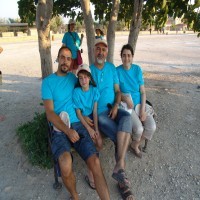Research Article
Aim & Scope
By bringing together the researchers from inside and outside the discipline of geography on the issues that are related to all fields of geography and by offering scientific solutions with production and sharing of information, Turkish Journal of Geographical Sciences aims to contribute to the studies in the field of geographical sciences on a national and international level.
Turkish Journal of Geographical Sciences is a media outlet of Ankara University Research Center of Turkish Geography (TUCAUM) and it has been published bianually as a refereed journal since 2003.
The journal contains original articles related to all fields of geography written by researchers of both the discipline of geography as well as researchers from other disciplines. The publishing policy of Turkish Journal of Geographical Sciences is to have empirical and review articles (model suggestions, literature reviews and discussions), mainly those with research and analysis based findings and gained through using recent scientific methods and techniques. Apart from the articles, the journal may also contain book reviews or critiques, some news that are related to reports on various congresses and symposiums as well as research reports.
The articles to be sent to the journal must be approved by the Editorial Board first. Additionally, the articles are published after being evaluated by at least two referees and receiving their feedback as being ‘publishable’. The articles which fail to receive the ‘publishable’ feedback from the referees or the editor cannot be published. It must be considered to keep the study under 25 pages in total (that includes the main article, references, charts/figures and photographs). The author bears full responsibility of their article which is published on the journal. When authors submit an article to the journal, they accept in advance that the study in question has not yet been published or sent to be published in another scientific media outlet. Accordingly, in order to be able to run a more effective article evaluation process and to increase the scientific quality of the journal, it is mandatory for authors to follow the stylistic features of the article. For the same reasons, it is recommended for authors to follow the structural features of the article in regards to the structure of the article.
Author Guidelines
(Turkish Journal of Geographical Sciences)
WRITING GUIDE
The articles to be sent to the journal must be written in accordance with the “Article Template”. When creating an article by using the Article Template, the authors are recommended to take advantage of the ‘Styles’ chapter on the Entry tab.
To download the Article Template Click here.
A. STYLISTIC FEATURES OF THE ARTICLE
1. PAGE STRUCTURE: The top, left, right and bottom margins of the page must be set at 2.5 cm. The articles must be written on a PC in MS Word.doc format. The letters must be size 11 in Times New Roman font with a line spacing of 1.25 and the paragraph space must be 6 nk and the first line indent must be set at 1.25 cm. There must not be any bold characters in the text, including the tables and figures.
2. TITLE OF THE ARTICLE: Considering that readers get their first impressions of an article from its title, it is crucial that the title completely reflects the purpose and limits of the article. In this regard, the title of the article must not be too long, i.e. it must not exceed 10 words. The title of the article must be left-aligned and it must be written with bold, size 16 letters in Times New Roman font (the first letters of each word must be capitalized). If the article is written in Turkish, then a second title must be written in English and vice versa. Of this second article, only the first letter of the first word must be capitalized (with the exception of proper nouns). The title must also be left-aligned and written with size 14 letters in Times New Roman font. The top and bottom paragraph spaces must be adjusted as 6 nk. After the first title, the name of the author, which is only to be included on an article that is approved to be published, must not include any titles. It must also be left-aligned and written with normal size 12 letters in Times New Roman font and the organization and ORCID information of the author(s) must be specified as a left-aligned footnote in normal size 9 letters in Times New Roman font. A contact/responsible author of the article must be identified and their e-mail address must be written left-aligned in size 9 letters under the first page as it is shown on the template.
2. ABSTRACT: The article must have an abstract written both in Turkish and English. As is known, an abstract leaves out the trivial details of an article and features the subject, purpose, method, tool(s) and techniques of data collection, type of analysis and findings or results of the study. Therefore, the abstract must include the purpose, sources of data, findings and results of the article. The abstract must not exceed 150 words. Abstracts must be single paragraph texts written in size 10 letters in italics and Times New Roman font. Only the Abstract titles must be written in bold and italics before the abstract text; there must also be five keywords.
3. KEYWORDS: Keywords allow easier accessibility in index and abstract databases that include published articles. Keywords must be accurate in order to obtain more rational results from database searches. The geographical area/region, where the study was conducted, must be indicated at the end. 5 keywords must be provided.
4. TEXT TITLES: The titles which are to be used in the article must be left aligned and written with size 11 letters in Times New Roman font. Their first letter must be capitalized; the paragraph indent must be 1.25 cm and the top and bottom spaces must be 6 nk. The titles, including the chapters of Introduction and Conclusion, must be stylized and numbered as shown in the template (The titles in the template and the explanations regarding the structural features of an article only serve as suggestions for authors). It is possible to use subtitles in compliance with the sub-targets / hypotheses of the study. The subtitles must be with a paragraph indent of 1.25 and their first letter must be capitalized.
Since the ‘Styles’ chapter in the text template is also organized in line with the text template, the titles, tables, figures & photographs, paragraphs, notes and sources can be organized by making use of this chapter.
5. TEXT AREA: The text area must have a line spacing of 1.25, top and bottom spaces of 6 nk and be aligned on both sides; it must be written with size 11 letters in Times New Roman font and the paragraph indent must be 1.25 cm for the first line only.
6. FIGURES AND TABLES: Records of figures, maps and photographs in the article must be in high definition that is appropriate for a high quality print; they must be properly positioned in the article text and their original copies must also be sent along with the article during the printing stage. Each and every map, table, chart, photograph, graphic or figure that are used, must be referenced in the text. Table titles must be written over and the table sources must be given under the tables. Tables must be structured as shown on the template and there must not be any kind of vertical lines, coloring or shading. Tables cannot include any bold characters. Only the first letter of the definitions of tables and figures is to be capitalized; all others letters must be lowercase. The same rule applies for the texts within tables. All tables must be named as ‘Table’; all graphics, maps and drawings must be named as ‘Figure’ and all photographs must be named as ‘Photo’. The names of figures and photographs (including definitions) must be given under the related figures or photographs. Names of all figures, tables and photographs must be written with size 9 letters Times New Roman font and there must be a full stop after each number. Figures, tables and photographs must be center aligned. The texts and source texts of figures, tables and photographs must be aligned with the starting point of the image.
7. NOTES: If a ‘Notes’ chapter will be included: Here,
the authors must give their footnotes under the title of ‘Notes’ before
references and acknowledgements chapters (if there is one). Notes must not have
any line indents and they must be written with size 9 letters in Times New
Roman font.
8. ACKNOWLEDGEMENTS AND ADDITIONAL INFORMATION: If an ‘Acknowledgements’ chapter will be included: In this chapter, author(s) can thank the people who have helped them while conducting their study; the individuals, institutions or organizations who have contributed with financial assistance or the individuals, institutions or organizations who have let them use their data. This note must be located at the end of the text of the study but before the references chapter.
9. REFERENCES: The references and sources used in the study must be specified. The quotations must be given in quotation marks if the word count is less than 40. If the word count is more than 40, however, quotations must be given in a separate paragraph without any quotation marks and in size 10 normal letters followed by a full stop. After the indented paragraph, spaces on each side must be 2 cm. References within the text and bibliography must follow the rules given below and the bibliography must be listed in alphabetical order. Only the studies that are mentioned in the text can be included in this chapter. This chapter must not include the names of any missing (mentioned in the text but not given as a reference) or extra (not mentioned in the text but given as a reference) sources. References must be listed in alphabetical order by the authors’ last names. References must be compiled under this title and they must be written with size 9 letters in Times New Roman format. Finally, the second indent of each work must be 1.00 cm.
Examples of Bibliography and References
This guide offers examples of referencing other authors. Due to rapid diversification of information sources, this chapter will be updated on a regular basis. Therefore, it is recommended for the author to check this chapter before sending their articles to our journal.
You can find some notes related to the expressional differences that are necessary for the articles written in English at the end of this guide.
References within the Text
- The authors are expected to give page numbers for the references in the text.
Examples
|
Number of authors |
Reference given in the text in parentheses format |
Reference given to the work in the text |
|
Single author |
(Aslan, 2017: 20) |
Aslan (2017: 20) |
|
Two authors |
(Aslan and Deniz, 2015: 60) |
Aslan and Deniz (2015: 60) |
|
Three or more authors |
(Aslan et al., 2015:13)
|
Aslan et al. (2015: 13) |
When referencing institutions, the name of the
institution must be written in full, followed by its abbreviation. It is
acceptable to use just this abbreviation when referencing the same institution again
in the text.
Example
First Use
According to the report published by the Ministry of National Education (MEB, 2013)…
In a report published in 2013 (Ministry of National Education, MEB)…
Further Use
In the report created by MEB (2013), the subject of lifelong learning was given a significant coverage.
Writing References
- If the same author was mentioned in many sources in the bibliography, the sources must be listed in chronological order from old to new.
Examples
These examples were created anonymously. The purpose is to show how different sources used in articles should be listed in the references.
Book written by a single author
İzgül, E. (2006). Coğrafya Bilmek. Ankara: Bahtiyar.
Book written by multiple authors
İzgül, E., Arslan, T. S., Ulucan, R. (2005). Coğrafya Bilmek. Ankara: Bahtiyar.
Book with an editor
İzgül, E. (Ed.) (2005). Coğrafya Bilmek. Ankara: Bahtiyar.
Chapter in a book with an editor
Ulucan, R. (2005). Coğrafyanın Tarihsel Gelişimi. Emel İzgül (Ed.), Coğrafya Bilmek içinde (115-135). Ankara: Bahtiyar
Book with multiple editions
İzgül, E., Arslan, T. S., Ulucan, R. (2005). Coğrafya Bilmek (3rd Edition). Ankara: Bahtiyar.
Article from a journal written by a single author
İzgül, E. (2010). Coğrafya Bilmek. Sosyal Bilimler Dergisi, 80 (2), 150-185. doi: 10.1237/0096- 2445.134.2.260
Article from a journal written by multiple authors
İzgül, E., Arslan, T. S., Ulucan, R. (2010). Coğrafya Bilmek. Sosyal Bilimler Dergisi, 80 (2), 150-185. doi: 10.1237/0096- 2445.134.2.260
Unpublished theses, posters, memorandums
- The URL extensions of theses from the National Thesis Center of the Council of Higher Education must also be included.
İzgül, E. (2010). Coğrafya Bilmek. Ankara University, Institute of Social Sciences, Unpublished Doctoral Thesis, Ankara. Obtained from: https://tez.yok.gov.tr/UlusalTezMerkezi/112545**-1
Internet Sources
- The sources taken from the internet must include a last access date.
İzgül, E. (2013, December 23). Coğrafyada Temel Kavramlar, taken on 10 December 2018 from the website http://cografyadersnotları.acikarsiv/Old.pdf
Statistics, reports
Published
Turkish Statistical Institute (TurkStat, 2012). Yaşlılık İstatistikleri, 1990-2010. Ankara: Türkiye İstatistik Kurumu Yayınları, Edition No: 12.
Unpublished
Turkish Statistical Institute (TurkStat, 2012). Yaşlılık İstatistikleri, 1990-2010. Taken on 10 December 2018 from the website http://tuiknufus/arsiv.pdf
Notes for the Articles Written in English
|
English
|
|
|
Çev. |
Trans. |
|
ve |
and |
|
vd. |
et al. |
|
Aktaran |
As cited in |
|
İçinde |
In |
|
Yayımlanmamış Yüksek Lisans Tezi |
Unpublished Master’s Thesis |
|
Yayımlanmamış Doktora Tezi |
Unpublished Doctoral Thesis |
|
Yayımlanmamış Uzmanlık Tezi |
Unpublished Expertise Thesis |
10. EXTENDED ABSTRACT IN ENGLISH
The articles which have been approved are expected to have an extended abstract.The extended abstract should contain a minimum of 1500 words and a maximum of 1800 words. The extended abstract must cover all the chapters (Introduction, Method, Findings and Conclusion) of the study in general. These chapters must also be given under separate titles in the text. The references given in the text should be used in the English extended abstract as much as possible.
B. STRUCTURAL FEATURES OF THE ARTICLE (The instructions given here serve only as examples)
1. INTRODUCTION: The purpose of this chapter is to make a general identification and analysis of the study. The readers should be provided with the purpose and subject of the study, its stages, chapters and ideas as well as the hypothetical framework on which the study is based upon. This chapter should have the answers to the questions of what the subject is, why the research was conducted, which chapters there are and what these chapters discuss. These questions may be related to purposes such as showing a problem, offering a solution to that problem and contributing to the literature in any field. This chapter may also include a literature review regarding the subject.
2. RELEVANT STUDIES: It may be given under introduction without necessarily reserving a separate title for it. Similar studies to the subject field of the article may be given in this chapter. As in the examples of ‘literature’ and ‘body of literature’, authors can name this chapter differently. This chapter briefly touches on which subjects were analyzed in the related studies under which methods and what kind of results have been obtained etc. In addition, it is important to mention the related studies in order to evaluate the contribution made by the article to the subject field.
4. MATERIALS AND METHOD: When starting this chapter, within the light of the descriptions thus far, the information related to the conducted study is presented in order to show the problems that exist or believed to exist as well as their solutions. Here, a complete description of the approach and the method to be used in the study is given. The reason for providing this information is to allow other researchers to repeat the same thing by making use of that method. This is why the method should be explained clearly for the sake of repeatability, which is the foundation of scientific knowledge. Here, the topics related to the features of the main body, the information collection technique, why this data collection technique is preferred and the pros and cons of the technique are all discussed. The study should explain in detail the subjects such as the development stages and content of the tool that was utilized for data collection. If the research was made by using one of the field research techniques; the chosen sampling technique and the reason for this choice should be explained with their reasons.
5. INTERPRETING THE ANALYSES AND FINDINGS: This chapter is where the main data of the study is analyzed. The analysis chapter only applies to the studies that are based on the collection of data. The articles of compilation (synopsis) generally do not have an analysis chapter. The explanations given here are generally related to the analysis of the data which is collected through field research techniques. The points such as the choice of the analysis type, statistical tests, confidence interval and the reason behind the choice of statistical tests etc. are explained in the introduction of the chapter. After these steps, it is time for interpreting the findings. In the chapter where the findings are interpreted; the analysis of the data and obtained results are given. Findings and research questions, in other words, the hypotheses are organized by assessment. The data is analyzed and interpreted in the light of hypotheses. The consistency of the findings and the hypothesis is assessed. The presentation can be achieved by making use of one or more from the methods of maps, tables, graphics or figures. The presentation of the results of statistical analysis is also included in this chapter. In the chapter of interpreting the analyses and findings, it would be appropriate to present the findings in single, double or multiple tables along with the results of statistical tests. In this way, it would be easier to comprehend the information regarding which test is used on which data. The chapter of interpreting the findings should be presented in two stages: The general information regarding the sampling (demographical data) and the information obtained from the research. The information obtained from research could be presented in one or multiple stages in itself. However, the author should be careful not to use too many tables while trying to clarify their article. The tables should be combined when it is possible and the tables that are unrelated to the research purpose/question should be avoided altogether. Moreover, it is better to present the general information with a single table.
6. CONCLUSION: This is the chapter where the results obtained from the article are given in a nutshell and the generalizations are made when they are necessary. This chapter should start with a short repetition of the problem at hand, followed by a short summary of the obtained results (for empirical studies). The statements should be short and clear. Any other possible scientific contributions to the related literature can be also summarized in this chapter. The author may also include here the statements that can pave the way for future researchers in the field. The author may refer to the subjects that need to be looked into and the points to be considered for the benefit of potential researchers.
Ethical Principles and Publication Policy
PUBLICATION ETHICS
Standards and Principles
Turkish Journal of Geographical Sciences (TJOGS) is a media outlet of Ankara University Research Center of Turkish Geography (TUCAUM) and it has been published bianually as a refereed journal since 2003.
FOCUS AND SCOPE
The journal contains original articles related to all fields of geography written by researchers of both the discipline of geography as well as researchers from other disciplines. The publishing policy of Turkish Journal of Geographical Sciences is to have empirical and review articles (model suggestions, literature reviews and discussions), mainly those with research and analysis based findings and gained through using recent scientific methods and techniques. Apart from the articles, the journal may also contain book reviews or critiques, some news that are related to reports on various congresses and symposiums as well as research reports.
The articles to be sent to the journal must be approved by the Editorial Board first. Additionally, the articles are published after being evaluated by at least two referees and receiving their feedback as being ‘publishable’. The articles which fail to receive the ‘publishable’ feedback from the referees or the editor cannot be published.
It must be considered to keep the study under 25 pages in total (including the main article, references, charts/figures and photographs). The author bears full responsibility of their article which is published on the journal. When authors submit an article to the journal, they accept in advance that the study in question has not yet been published or sent to be published in another scientific media outlet. Accordingly, in order to be able to run a more effective article evaluation process and to increase the scientific quality of the journal, it is mandatory for authors to follow the stylistic features of the article. For the same reasons, it is recommended for authors to follow the structural features of the article in regards to the structure of the article.
PUBLICATION LANGUAGE
The languages for publication are Turkish and English. The articles must have two abstracts, one of which has to be in Turkish. The articles written in Turkish must also have an abstract in English and vice versa. The articles can be published in both languages.
PUBLICATION FREQUENCY
Turkish Journal of Geographical Sciences (TJOGS) which is published under Ankara University Research Center of Turkish Geography (TUCAUM) has been active since 2003. The journal is published biannually on the months of April and October.
PRICING
Turkish Journal of Geographical Sciences (TJOGS) does not request any fees during the transfer, evaluation and publication stages of articles. The authors are not required to pay for any transaction fees for the studies they submit to the journal.
INDEXING/REVIEW
Turkish Journal of Geographical Sciences (TJOGS) is indexed by ULAKBİM Database of Social Sciences, Social Science Research Network (SSRN), SOBIAD and DOAJ.
COPYRIGHT
The authors are responsible for the ideas and suggestions as well as the credibility of sources in the articles. The authors are not paid any royalties for the articles published in the journal. By acknowledging that they waive the copyrights for their articles, the authors transfer the copyrights of their approved articles to Turkish Journal of Geographical Sciences (TJOGS). The Editorial Board is given authorization in regards to publishing the articles. On the other hand, the authors must possess the following rights:
1. All the authorized rights except for the copyright.
2. The right to reproduce the article for their own purposes except for the intention of selling it.
3. The right to use a part of or the whole article in other works they may create such as books, articles etc. under the condition that they give the Journal as a reference.
REPORT ABOUT REVISIONS
When authors submit their revised papers, they should attach a reports that have to includes the list of revisions and their responses to the reviewers.
EXTENDED ABSTACT
The author(s), whose work has been approved for publication, are required to submit an extended abstract written in English between 1500-1800 words covering all the chapters of the work (introduction, method, findings and conclusion) in general.
TRACKING AN ARTICLE
The authors can request information as to which stage the articles they have submitted to the journal are at (stages of field editor evaluation and referee evaluation) by sending an e-mail to tucaum.cbd@gmail.com and asking the status of their article or –when it is absolutely necessary– by calling the administrative editor on the phone (Res. Asst. Dr. Ayla Deniz: +90(312) 310 32 80/1207).
OPEN ACCESS POLICY
Open access enables the global access to knowledge. Turkish Journal of Geographical Sciences (TJOGS) adopts the open access policy.
USE
Within the scope of open access mandate, Turkish Journal of Geographical Sciences (TJOGS) can be used, reproduced and shared under the condition that it is given credit. The official website of the journal is http://dergiler.ankara.edu.tr/detail.php?id=33 and the readers can access all the articles published on the journal on this website.
Price Policy
Makale gönderim ve yayınlama ücreti alınmamaktadır.
Indexes
Citation Indexes
Other Indexes
Journal Boards
Editor in Chief

Editors






Administrative Editors


Advisory Board















 Web
Web






 Web
Web




Language Editor



I am currently pursuing my PhD in the Department of Geography at the Institute of Social Sciences, Ankara University, while also working as a research assistant in the same university's Department of Geography. I completed my undergraduate studies in Geography at Ondokuz Mayıs University between 2009 and 2013, and earned my master’s degree at Ankara University between 2016 and 2019. My master’s thesis was titled “Circular Labor Mobility from Georgia to Turkey: Processes, Patterns, and Outcomes.” I am currently working on my doctoral dissertation titled “The Production of Otherness from a Bourdieusian Perspective.” Through this research, I analyze how exclusionary practices are produced at the intersection of class, cultural capital, and space, and how these processes intertwine with everyday life at the neighborhood scale.
My research focuses on themes such as migration, othering, gender, labor, everyday life, class differentiation, and spatial justice. I am particularly interested in the ethnicization of labor, class-based spatial segregation, and the political nature of urban daily life. I combine qualitative methods with a critical geography perspective, aiming to engage with the concepts of neighborhood, labor, and otherness in a theoretically grounded way.
Between 2024 and 2025, I spent a year as a visiting researcher at Utrecht University’s Department of Human Geography and Spatial Planning in the Netherlands. During this time, I conducted a TÜBİTAK-funded research project comparing exclusionary discourses and practices targeting refugees in Turkey and the Netherlands. This experience allowed me to gain deeper insight into the transnational dimensions of othering and its manifestations in different contexts.
Social Media Editor

Layout Editors




Turkish Journal of Geographical Sciences licensed under a Creative Commons Attribution-NonCommercial-Non-Derivatives 4.0 International Licence (CC BY-NC-ND 4.0).








